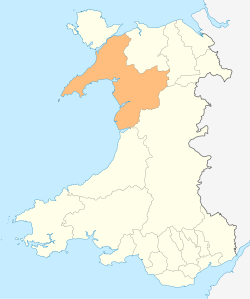| Abergynolwyn | |
|---|---|
 Abergynolwyn | |
Location within Gwynedd | |
| OS grid reference | SH679070 |
| Community | |
| Principal area | |
| Preserved county | |
| Country | Wales |
| Sovereign state | United Kingdom |
| Post town | TYWYN |
| Postcode district | LL36 |
| Dialling code | 01654 |
| Police | North Wales |
| Fire | North Wales |
| Ambulance | Welsh |
| UK Parliament | |
| Senedd Cymru – Welsh Parliament | |
Abergynolwyn (English: Mouth of the River with a Whirlpool) is a village in southern Gwynedd, Wales, located at the confluence of the Nant Gwernol and the Afon Dysynni. [1] The population of the community which is named after the village of Llanfihangel-y-Pennant was 339 at the 2011 census.


